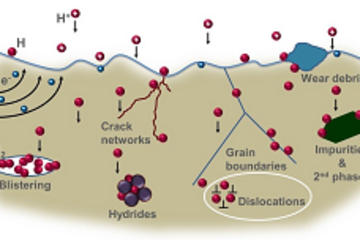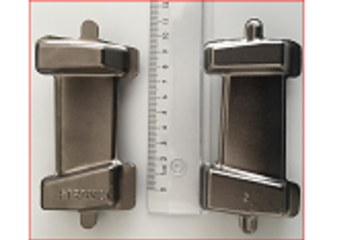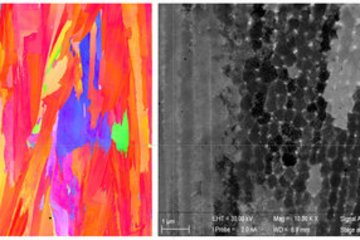All genres
921.
Book
Crystal Plasticity Finite Element Methods in Materials Science and Engineering. Wiley-VCH, Weinheim (2010), 197 pp.
922.
Book
Computational Materials Engineering – An Introduction to Microstructure Evolution. Academic Press, Elsevier, USA (2007), 360 pp.
923.
Book
Continuum Scale Simulation of Engineering Materials Fundamentals - Microstructures - Process Applications. WILEY-VCH, Weinheim (2004), 855 pp.
924.
Book
Computational Materials Science - The Simulation of Materials Microstructures and Properties. Wiley-VCH (1998), 402 pp.
925.
Book Chapter
Iron-rich High Entropy Alloys. In: High-Performance Ferrous Alloys, pp. 389 - 421 (Ed. Rana, R.). Springer Nature Switzerland, Cham, Switzerland (2021)
926.
Book Chapter
Spectral Solvers for Crystal Plasticity and Multi-physics Simulations. In: Handbook of Mechanics of Materials, pp. 1347 - 1372 (Eds. Hsueh, C.-H.; Schmauder, S.; Chen, C.-S.; Chawla, K. K.; Chawla, N. et al.). Springer, Singapore (2019)
927.
Book Chapter
Recovery and Recrystallization: Phenomena, Physics, Models, Simulation. In: Physical Metallurgy: Fifth Edition, Vol. 1, pp. 2291 - 2397. Elsevier Inc., New York, NY, USA (2014)
928.
Book Chapter
Interface segregation in advanced steels studied at the atomic scale. In: Microstructural Design of Advanced Engineering Materials, pp. 267 - 298 (Ed. Molodov, D. A.). Wiley-VCH Verlag GmbH & Co. KGaA, Weinheim, Germany (2013)
929.
Book Chapter
Multi‐scale Modelling of a Biological Material: The Arthropod Exoskeleton. In: Materials Design Inspired by Nature: Function Through Inner Architecture (CHAPTER 9), pp. 197 - 218 (Eds. Fratzl, P.; Dunlop, J.W.C.; Weinkamer, R.) (2013)
930.
Book Chapter
Ab Initio Guided Design of Materials. In: Structural Materials and Processes in Transportation, pp. 481 - 495 (Eds. Lehmhus, D.; Busse, M.; Herrmann, A. S.; Kayvantash, K.). Wiley-VCH Verlag GmbH & Co. KGaA, Weinheim, Germany (2013)
931.
Book Chapter
Crystal Plasticity Modeling. In: Microstructural Design of Advanced Engineering Materials, 3, pp. 41 - 57 (Ed. Molodov, D. A.). Wiley-VCH Verlag GmbH Co. KGaA, Weinheim (2013)
932.
Book Chapter
Hierarchical modeling of biological nanocomposites. In: Mechanics of Nanomaterials and Nanotechnology, pp. 199 - 224 (Eds. Kavardzhikov, V.; Parashkevova, L.; Baltov, A.). Institute of Mechanics - BAS, Sofia, Sofia, Bulgaria (2012)
933.
Book Chapter
Chitin in the exoskeletons of arthropoda: From ancient design to novel materials science. In: Chitin, pp. 35 - 60 (Ed. editor), N. S. G. (.). Springer, Germany (2011)
934.
Book Chapter
Anwendung der Textur-Komponenten-Kristallplastizitäts-FEM für die Simulation von Umformprozessen unter Berücksichtigung des Texturgradienten. In: Prozessskalierung, Strahltechnik, Tagungsband des 2. Kolloquiums Prozessskalierung im Rahmen des DFG Schwerpunktprogramms Prozessskalierung, Vol. 27, pp. 157 - 166 (Ed. Vollertsen, F.). BIAS-Verlag, Bremen (2005)
935.
Book Chapter
Drowning in data - A viewpoint on strategies for doing science with simulations. In: Handbook of Materials Modeling, pp. 2687 - 2693 (Ed. Yip, S.). Springer, The Netherlands (2005)
936.
Book Chapter
Recrystallization Simulation by use of Cellular Automata. In: Handbook of Materials Modeling, pp. 2173 - 2203 (Ed. Yip, S.). Springer, Netherlands (2005)
937.
Book Chapter
How do 10^10 crystals co-deform. In: Weitab vom Hookeschen Gesetz -- Moderne Ansätze der Ingenieurpraxis großer inelastischer Deformationen metallischer Werkstoffe (Eds. Kollmann, F. G.; G., G.; Akademie der Wissenschaften und der Literatur, Mainz, Germany). Franz Steiner Verlag, Stuttgart, Germany (2005)
938.
Book Chapter
Cellular, Lattice Gas, and Boltzmann Automata. In: Continuum Scale Simulation of Engineering Materials (Eds. Raabe, D.; Roters, F.; Bariat, F.; Chen, L.-Q.; Wiley-VCH). Wiley-VCH, Weinheim (2004)
939.
Proceedings
Proceedings of the 2nd High Mangenese Steels Conference 2014 (2nd HMnS). 2nd High Mangenese Steels Conference 2014 (2nd HMnS), Aachen, Germany, August 31, 2014 - September 04, 2014. RWTH Aachen University, Aachen, Germany (2014), 484 pp.
940.
Conference Paper
Hydrogen Plasma Reduction of Iron Oxides. Advances in Pyrometallurgy Symposium, held at the TMS Annual Meeting and Exhibition, TMS 2023, San Diego, CA, USA, March 19, 2023 - March 23, 2023. The Minerals, Metals & Materials Serie, pp. 83 - 84 (2023)








